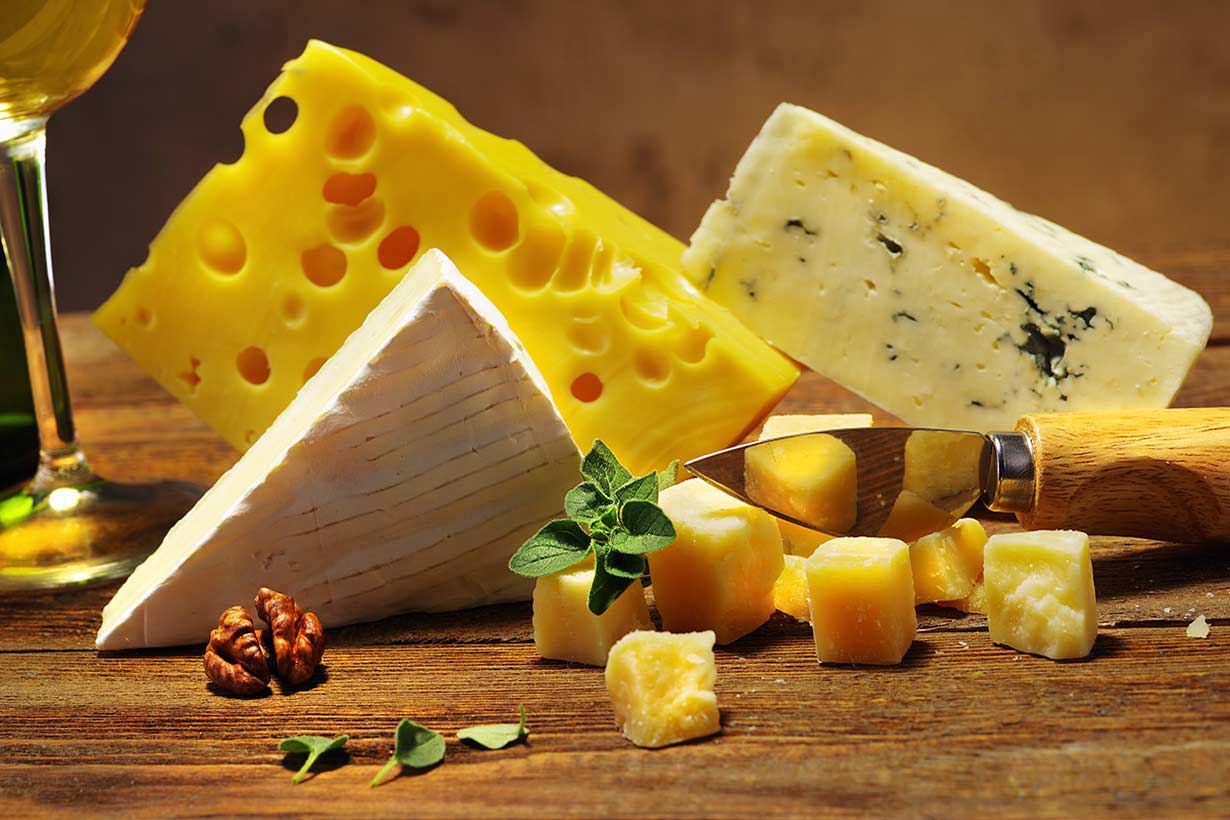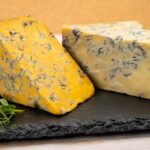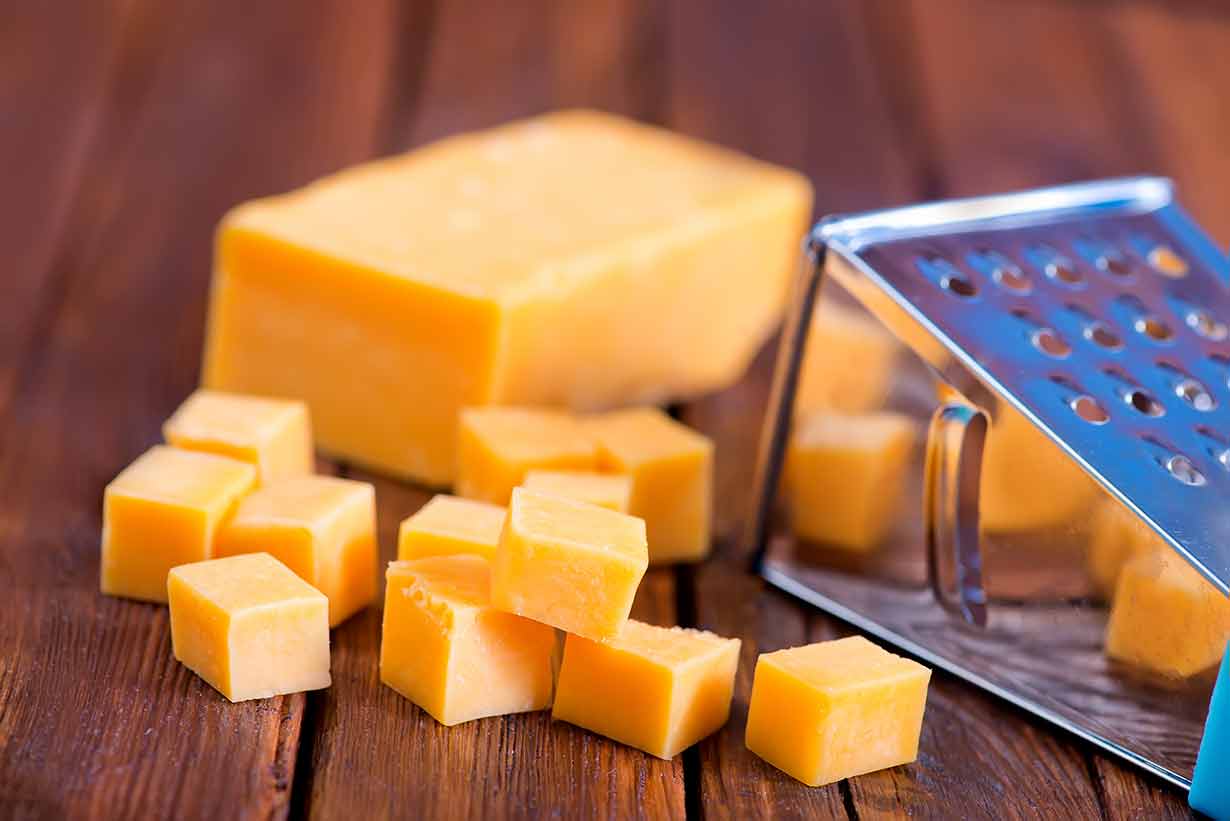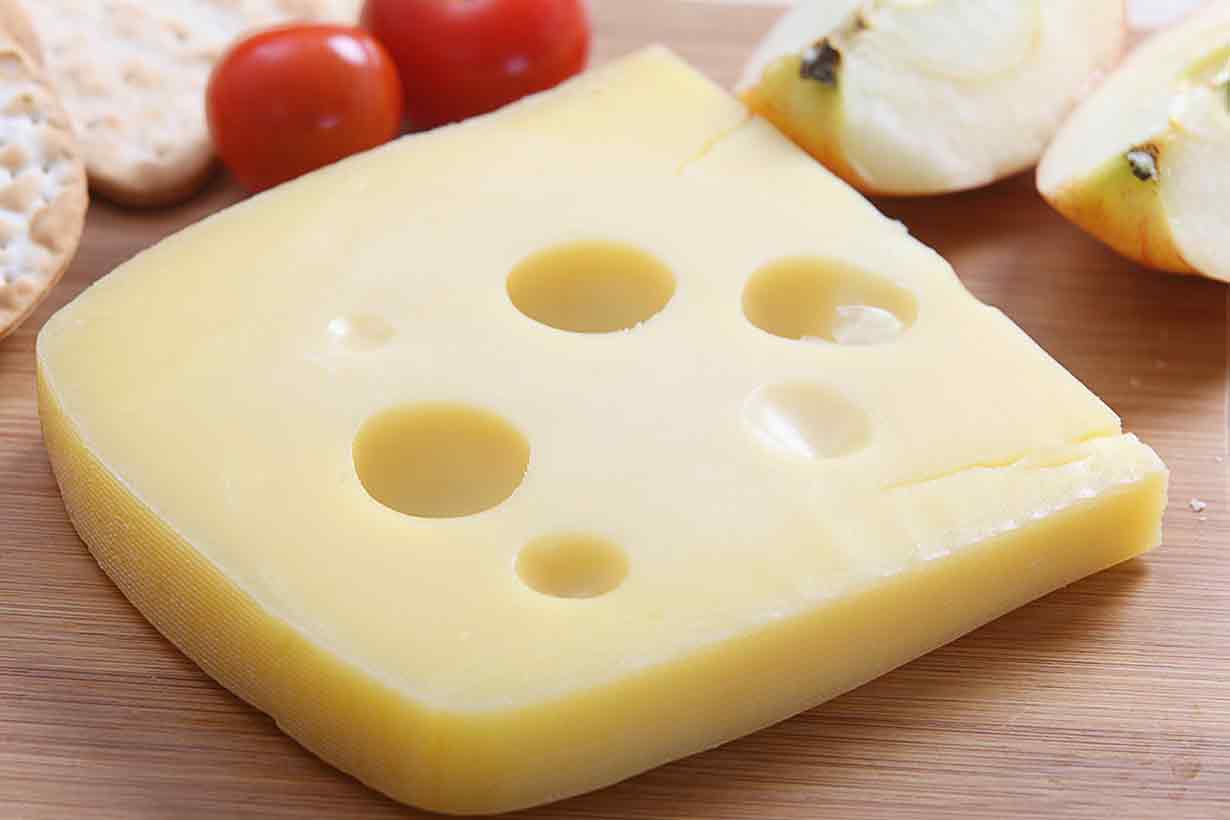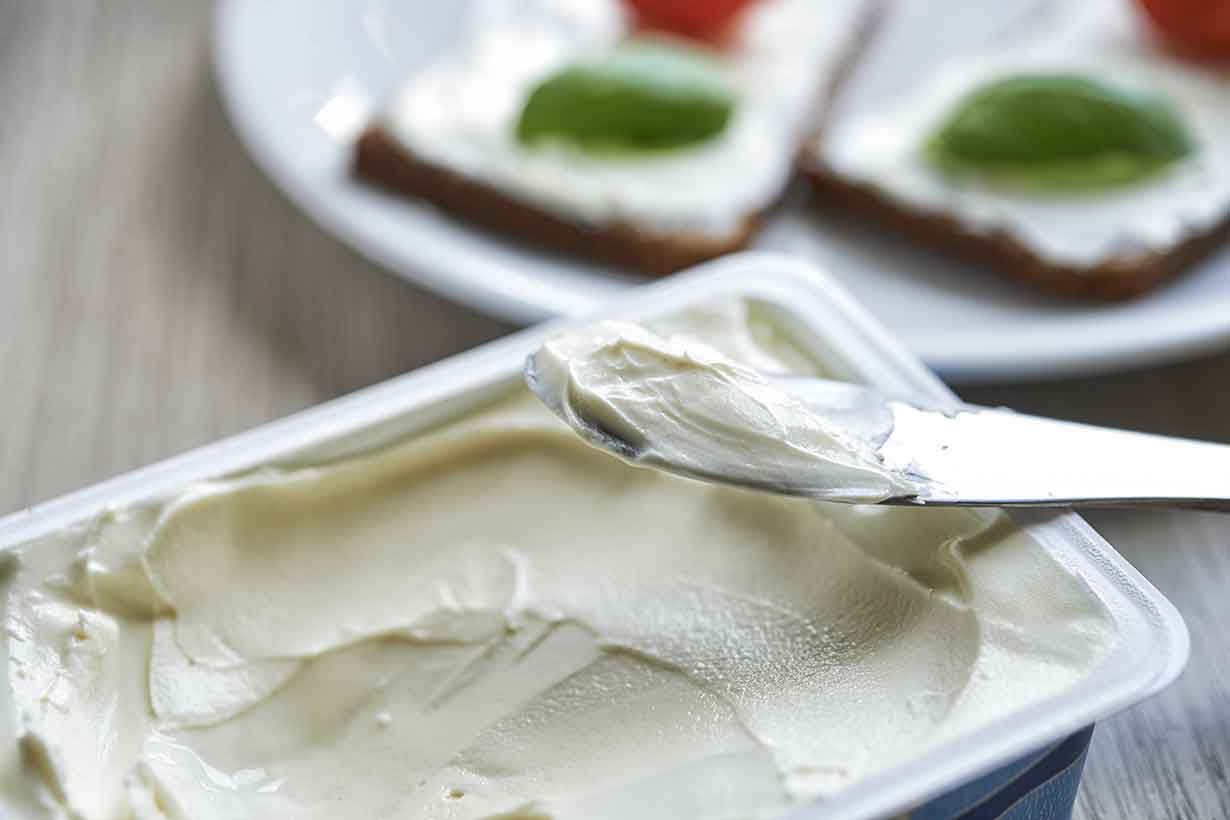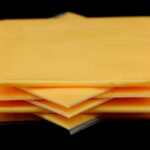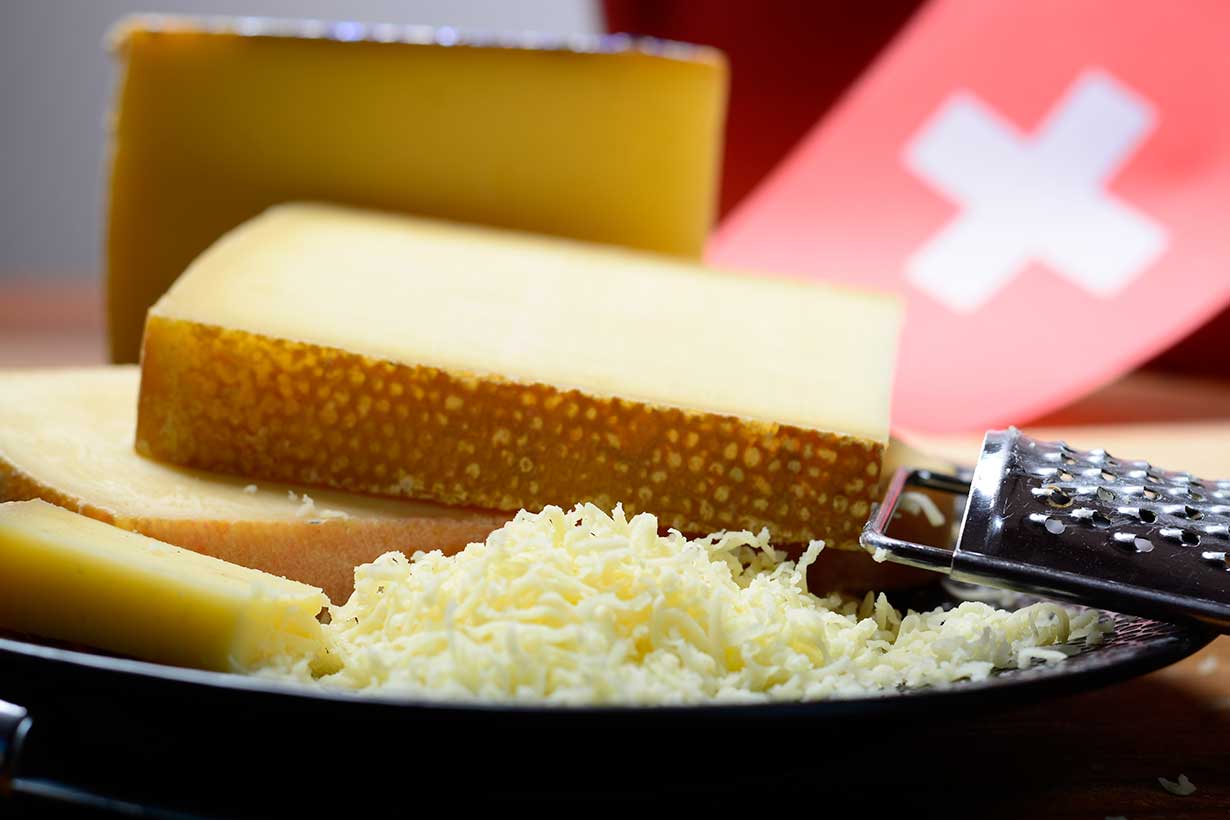When we hear the words Swiss cheese, we may conjure the image of the stereotypical cheese adorned with holes.
However, as one of the world’s largest cheese producers, Switzerland offers a wide array of Swiss cheese varieties.
This article examines some of the most renowned varieties, detailing their characteristics and nutritional properties.
But before we proceed, let’s first delve into Swiss cheese in more detail.
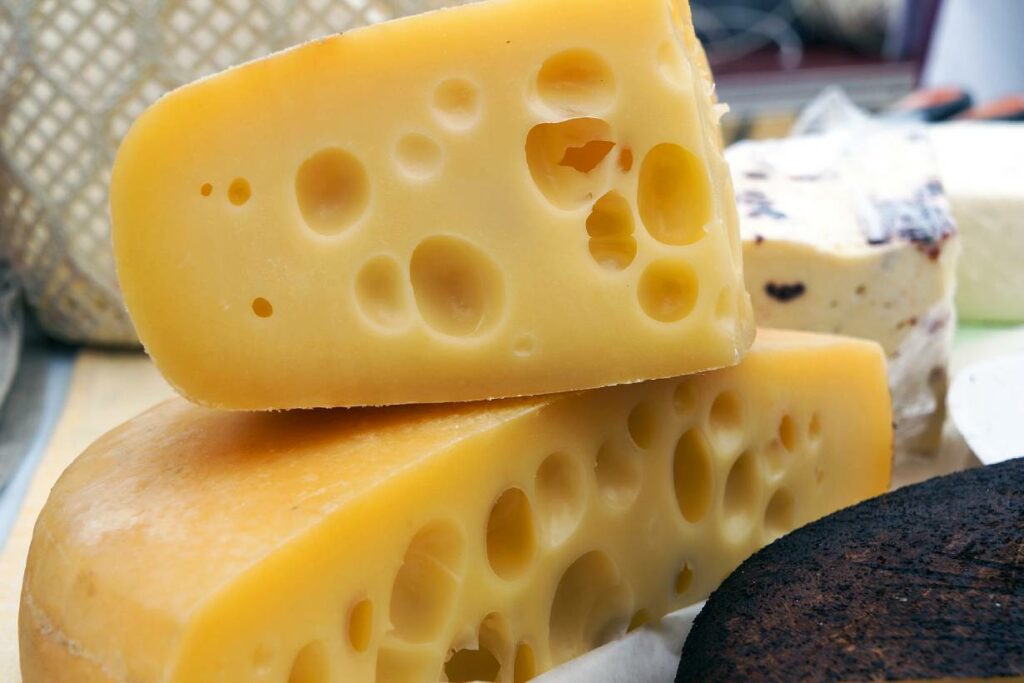
Table of contents
What Is Swiss Cheese?
The term “Swiss cheese” can carry two distinct meanings. Firstly, it simply refers to cheese originating from Switzerland, of which there are numerous types.
However, there’s a second interpretation, encompassing a range of cheeses categorized as ‘Swiss-style’.
These Swiss-style cheeses are easily recognizable by their characteristic appearance, marked by large holes formed during fermentation. A prime example of this style is Emmental, a medium-hard cheese with a subtle flavor profile.
For the purpose of this guide, we’ll define Swiss cheese as cheese originating from Switzerland, comprising a range of varieties.
Within this context, Swiss cheese exhibits diverse characteristics and nutritional properties, varying based on the specific type.
A List of Swiss Cheese Varieties
Here are 12 of the famous cheese options from Switzerland.
For each cheese, you can observe its characteristics and basic nutritional facts.
1) Appenzeller
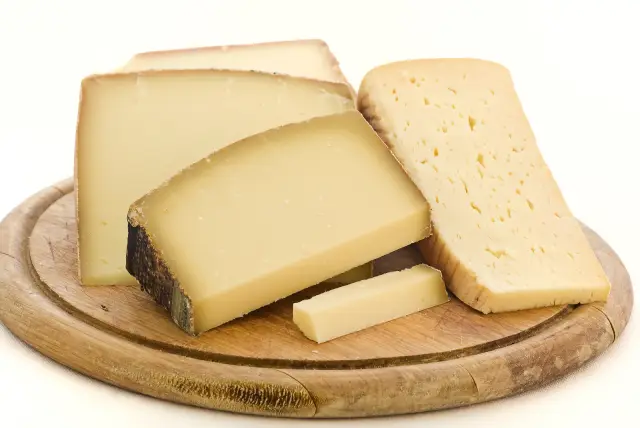
Appenzeller is a medium-hard cheese made from cow’s milk and fermented for at least three months. Originating from Appenzell in Switzerland, a region renowned for its picturesque green hills that attract numerous tourists.
Known for its notably robust flavor, Appenzeller has earned the title of ‘one of the most flavoursome cheeses in Switzerland’ (1).
Throughout the maturation process, the wheels of Appenzeller cheese undergo regular washing with a herbal brine, imparting tangy flavor notes to the final product (2).
Below are the typical nutritional values per ounce (28 grams) of Appenzeller cheese (3):
- Calories: 110
- Carbohydrates: 1g
- Fat: 9g
- Saturated fat: 5g
- Protein: 7g
- Cholesterol: 25 mg
- Sodium: 150 mg
2) Berner Alpkäse
Berner Alpkäse is a Swiss cheese hailing from the Berner Alps region of Switzerland.
This cheese boasts a firm texture and undergoes a maturation process typically lasting from between 4.5 and 12 months (4).
The intensity of the cheese’s flavor varies depending on the duration of maturation, ranging from mild to robust.
Moreover, there exists an extra hard and longer-matured version of the cheese known as Berner Hobelkäse, with a minimum maturation period of eighteen months (5).
Interestingly, Berner Hobelkäse is thought to have been made within the region for nearly 500 years, with historical records dating back to 1548 (6).
Berner Alpkäse holds a ‘Protected Designation of Origin,’ ensuring that any cheese bearing its name must originate from the Bernese Alps area of Switzerland (6).
Nutritionally, the cheese closely resembles Appenzeller. Here are the nutritional values of Berner Alpkäse per ounce (28g) serving (7):
- Calories: 110
- Carbohydrates: 1g
- Fat: 9g
- Saturated fat: 5g
- Protein: 7g
- Cholesterol: 25 mg
- Sodium: 110 mg
3) Emmental
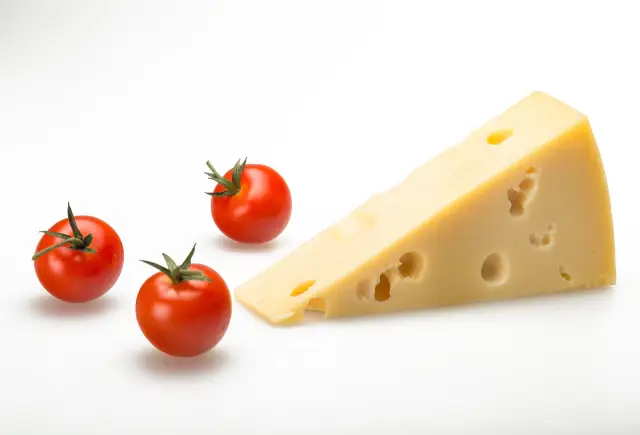
Emmental is an iconic Swiss cheese known for its distinctive appearance, so much so that many simply refer to Emmental as “Swiss cheese.”
Characterized by its pale yellow color adorned with large “eyes” (holes) that occupy nearly as much space as the solid cheese itself, Emmental is instantly recognizable.
This medium-hard cheese varies in strength from mild to medium, dependent on the maturation period. Overall, Emmental presents a mild yet nutty and slightly creamy flavor profile.
With historical records dating back to 1293, Emmental holds a Protected Designation of Origin (PDO), stipulating its production must be confined to the region of Emmental, Switzerland (8).
It is similar to several other European cheeses, including Jarlsberg.
Emmental boasts the following nutritional composition per ounce (28g) serving (9):
- Calories: 110
- Carbohydrates: 0g
- Fat: 9g
- Saturated fat: 5g
- Protein: 8g
- Cholesterol: 25 mg
- Sodium: 48 mg
4) Gruyère
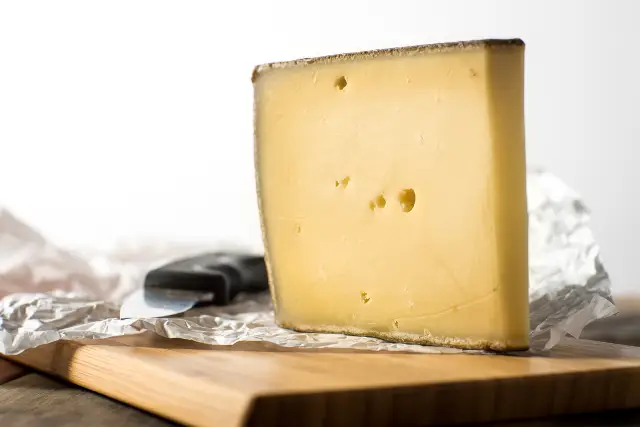
Gruyère stands as one of the most renowned Swiss cheeses, praised for its mild and subtly nutty taste.
There are many similarities between Emmental and Gruyère; both possess a relatively mild flavor and belong to the category of medium-hard cheeses.
However, Gruyère distinguishes itself with a slightly more pronounced flavor profile. It is also a solid cheese, and lacks the chatacteristic holes of Emmental.
Gruyère also boasts a rich history, with its production dating back to the 12th century and its first appearance in a dictionary coming in the 17th century (9).
‘Swiss Gruyère’ holds a Protected Designation of Origin, allowing its exclusive production in Switzerland. However, ‘French Gruyère’ also exists, requiring explicit labeling as ‘French’ (9).
The nutritional breakdown per ounce (28 grams) of Swiss Gruyère is as follows (10):
- Calories: 116
- Carbohydrates: 0.1g
- Fat: 9.1g
- Saturated fat: 5.3g
- Protein: 8.4g
- Cholesterol: 31 mg
- Sodium: 200 mg
For more on Gruyère, please refer to this in-depth guide:
What Is Gruyère Cheese? A Complete Guide
5) Le Maréchal
Le Maréchal is a modern variety of Swiss cheese with production commencing as recently as 1992 (11).
Crafted solely with local milk from 13 farms in the Vaud region of Switzerland (12).
Le Maréchal has an appearance reminiscent of Gruyère, albeit distinguised by its darker brown rind.
In terms of flavor, it doesn’t depart too much from traditional Swiss cheeses, boasting a nutty and sweet flavor. During the ripening process, producers flavor the cheese by brushing its rind with fresh herbs (12).
Le Maréchal has the following nutritional properties per ounce (28-gram) serving (13):
- Calories: 120
- Carbohydrates: 0g
- Fat: 10g
- Saturated fat: 7g
- Protein: 8g
- Cholesterol: 28 mg
- Sodium: 160 mg
6) Raclette

Raclette, a popular semi-hard Swiss cheese, is widely recognized for its use as a melted cheese. It’s commonly melted and used in fondues, gratins, sandwiches, and as a topping on foods like pizza, pasta dishes, meats, potatoes, and vegetables.
This widespread use is due to Raclette’s excellent melting properties and melts with, which yield a consistent, creamy texture. On this note, there are even dedicated appliances to melt the cheese, such as a ‘Raclette oven’ and various ‘Raclette grills,’ designed specifically for heating Raclette cheese (14).
Furthermore, there exists a Swiss dish called ‘Raclette,’ where melted Raclette cheese accompanies foods such as potatoes, onions, and dried meat (15).
The nutritional values per ounce (28 grams) of Raclette are as follows (16):
- Calories: 100
- Carbohydrates: 0g
- Fat: 8.0g
- Saturated fat: 6.0g
- Protein: 6.0g
- Cholesterol: 25 mg
- Sodium: 210 mg
7) Sbrinz
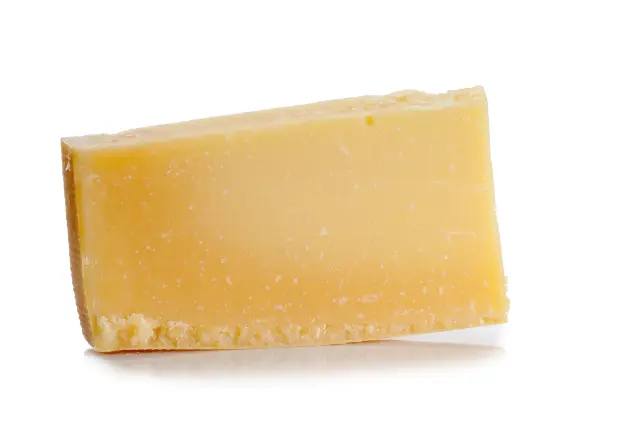
Sbrinz is an extra-hard Swiss cheese that shares characteristics with the Italian cheese Parmesan.
The cheese undergoes a lengthy maturation process, with 22 months being deemed as the optimal duration “to develop its full flavor” (17).
Sbrinz undergoes production in 22 dairies located within the Central Switzerland area (18).
It is among the most popular Swiss cheese options, and is often grated onto foods as a topping.
Due to its excellent melting properties, Sbrinz is a versatile edition to various dishes such as pasta, salads, pizza, soups, and stews.
Here is the nutritional composition of Sbrinz per ounce (28-gram) serving (19):
- Calories: 116
- Carbohydrates: 0g
- Fat: 9.3g
- Saturated fat: 5.6g
- Protein: 6.0g
- Cholesterol: 25 mg
- Sodium: 210 mg
8) Schabziger

Schabziger is a unique Swiss cheese distinguished by its pale green color.
Made by combining skimmed cow’s milk with a herb called blue fenugreek, the cheese undergoes heating and then pressing into cone-like shapes, before maturing for a period from two to six months (20, 21).
In addition to its distinct appearance, Schabziger offers a unique flavor profile that combines tangy, herby, and earthy notes, complemented by its crumbly texture.
Among its various uses, Schabziger finds its way into sandwiches and serves as a topping on various foods. Production of the cheese has a history dating back to 1463 (22).
Since Schabziger uses skimmed milk for its production, it has a lower fat and calorie content compared to other Swiss cheese varieties.
Nutritionally, here are its values per ounce (28-gram) serving (23):
- Calories: 53
- Carbohydrates: 1.7g
- Fat: 3.4g
- Saturated fat: 2.3g
- Protein: 3.7g
- Cholesterol: 0 mg
- Sodium: 0 mg
9) Tête de Moine

Tête de Moine, which translates to “Monk’s Head” in English, derives its name to the first producers of Tête de Moine, who were monks living around 800 years ago in the Jura mountains of Bern, Switzerland (24).
Tête de Moine shares some similarities to Gruyère; both are semi-hard Swiss cheeses with nutty flavors.
However, it is perceived that Gruyère has a milder flavor compared to the slightly stronger taste of Tête de Moine.
Similar to many semi-hard cheese options, Tête de Moine is a versatile cheese with many uses. It can be added to dishes for flavoring purposes or enjoyed on its own or with accompaniments.
An ounce (28g) serving of Tête de Moine provides the following nutritional values (25):
- Calories: 112
- Carbohydrates: 0g
- Fat: 9.2g
- Saturated fat: 5.6g
- Protein: 7.0g
- Cholesterol: –
- Sodium: –
10) Tomme Vaudoise
Tomme Vaudoise is a soft cheese bearing resemblance to the French cheese Brie in appearance.
However, while it has a soft and creamy taste, it is neither as soft nor as creamy as Brie and possesses earthier flavor notes.
Produced in the Vaud region of Western Switzerland, Tomme Vaudoise undergoes a short aging period, with some cheeses maturing for as little as two weeks (26).
Nutritionally, here are the values per ounce (28-gram) serving (27):
- Calories: 74
- Carbohydrates: 0g
- Fat: 5.9g
- Saturated fat: 3.6g
- Protein: 5.3g
- Cholesterol: –
- Sodium: 134 mg
11) Vacherin Mont d’Or

Vacherin Mont d’Or is a soft Swiss cheese originating from the Jura region of Switzerland (28).
Typically melted in the oven until achieving a creamy consistency, it is served alongside bread, potatoes, fruit, and vegetables, either as a topping or a dip.
Vacherin Mont d’Or melds its soft and creamy texture with earthy, nutty flavors. It is neither a mild nor particularly pungent cheese.
Nutritionally, Vacherin Mont d’Or offers the following profile per ounce (28g) serving (29):
- Calories: 82
- Carbohydrates: 0.1g
- Fat: 6.7g
- Saturated fat: 4.2g
- Protein: 5.3g
- Cholesterol: –
- Sodium: 0.4 mg
12) Vachere Fribourgeois

Vacherin Fribourgeois is a semi-hard Swiss cheese originating from the Fribourg region of Switzerland (30).
Featuring a mild flavor and smooth texture, its characteristics may vary slightly depending on the duration of aging.
Similar to other medium-hard cheeses like Cheddar, Vacherin Fribourgeois is versatile, finding its way into a range of cooked dishes, sandwiches, cheese platters, or simply enjoyed on its own.
An ounce (28-gram) serving of Vacherin Fribourgeois provides the following nutritional profile (31, 32):
- Calories: 104
- Carbohydrates: 0.4g
- Fat: 8.4g
- Saturated fat: 5.0g
- Protein: 6.7g
- Cholesterol: –
- Sodium: 165 mg
Final Thoughts
As shown in this guide, while there is a widely recognized ‘Swiss cheese’ style, there are also many different varieties of Swiss cheese.
Each offers distinct characteristics and nutritional profiles, and all are worth trying for those who enjoy cheese.
For those who want Swiss cheese with fewer calories, there are also fat-free versions of Swiss cheese available.

